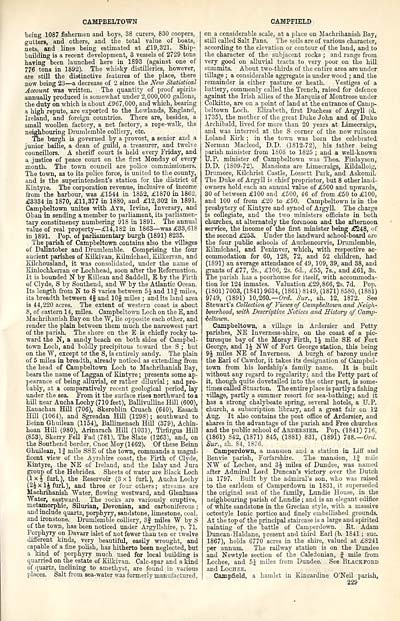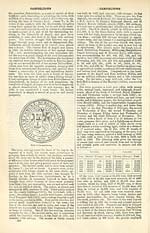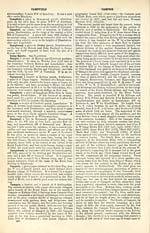Ordnance gazetteer of Scotland
(237) Page 229
Download files
Complete book:
Individual page:
Thumbnail gallery: Grid view | List view

CAMPBELTOWN
being 1087 fishermen and boys, 38 curers, 830 coopers,
gutters, and others, and the total value of boats,
nets, and lines being estimated at £19,321. Ship-
building is a recent development, 3 vessels of 2729 tons
having been launched here in 1893 (against one of
776 tons in 1892). The whisky distilleries, however,
are still the distinctive features of the place, there
now being 23 — a decrease of 2 since the New Statistical
Account was written. The quantity of proof spirits
annually produced is somewhat under 2,000,000 gallons,
the duty on which is about £967,000, and which, bearing
a high repute, are exported to the Lowlands, England,
Ireland, and foreign countries. There are, besides, a
small woollen factory, a net factory, a rope-walk, the
neighbouring Drumlemble colliery, etc.
The burgh is governed by a provost, a senior and a
junior bailie, a dean of guild, a treasurer, and twelve
councillors. A sheriff court is held every Friday, and
a justice of peace court on the first Monday of every
month. The town council are police commissioners.
The town, as to its police force, is united to the county,
and is the superintendent's station for the district of
Eintyre. The corporation revenue, inclusive of income
from the harbour, was £1544 in 1852, £1870 in 1862,
£3334 in 1870, £11,377 in 1880, and £12,302 in 1891.
Campbeltown unites with Ayr, Irvine, Inverary, and
Oban in sending a member to parliament, its parliamen-
tary constituency numbering 918 in 1891. The annual
value of real property— £14,182 in 1863— was £33,618
in 1891. Pop. of parliamentary burgh (1891) 8235.
The parish of Campbeltown contains also the villages
cf Dalintober and Drumlemble. Comprising the four
ancient parishes of Kilkivan, Kilmichael, Eilkerran, and
Kilchousland, it was consolidated, under the name of
Kinlochkerran or Lochhead, soon after the Reformation.
It is bounded N by Eillean and Saddell, E by the Firth
of Clyde, S by Southend, and W by the Atlantic Ocean.
Its length from N to S varies between 5J and llf miles,
its breadth between 4§ and lOg miles ; and its land area
is 44,220 acres. The extent of western coast is about
8, of eastern 14, miles. Campbeltown Loch on the E, and
Machrihanish Bay on the W, lie opposite each other, and
render the plain between them much the narrowest part
of the parish. The shore on the E is chiefly rocky to-
ward the N, a sandy beach on both sides of Campbel-
town Loch, and boldly precipitous toward the S ; but
on the W, except td the S, is entirely sandy. The plain
of 5 miles in breadth, already noticed as extending from
the head of Campbeltown Loch to Machrihanish Bay,
bears the name of Laggan of Eintyre ; presents some ap-
pearance of being alluvial, or rather diluvial ; and pro-
bably, at a comparatively recent geological period, lay
under the sea. From it the surface rises northward to a
hill near Aucha Lochy (710 feet), Ballivulline Hill (600),
Ranachan Hill (706), Skeroblin Cruach (640), Easach
Hill (1064), and Sgreadan Hill (1298) ; southward to
Beinn Ghuilean (1154), Ballimenach Hill (379), Achin-
hoan Hill (980), Arinarach Hill (1031), Tirfirgus Hill
(853), Skerry Fell Fad (781), The Slate (1263), and, on
the Southend border, Cnoc Moy (1462). Of these Beinn
Ghuilean, If mile SSE of the town, commands a magni-
ficent view of the Ayrshire coast, the Firth of Clyde,
Eintyre, the NE of Ireland, and the Islay and Jura
group of the Hebrides. Sheets of water are Black Loch
(lx| furh), the Reservoir (3x1 furL), Aucha Lochy
(2JxlJ furL), and three or four others; streams are
Machrihanish Water, flowing westward, and Glenlussa
Water, eastward. The rocks are variously eruptive,
metamorphic, Silurian, Devonian, and carboniferous ;
and include quartz, porphyry, sandstone, limestone, coal,
and ironstone. Drumlemble colliery, 3| miles W by S
of the town, has been noticed under Argyllshire, p. 71.
Porphyry on Davarr islet of not fewer than ten or twelve
different kinds, very beautiful, easily wrought, and
capable of a fine polish, has hitherto been neglected, but
a kind of porphyry much used for local building is
quarried on the estate of Eilkivan. Calc-spar and a kind
of quartz, inclining to amethyst, are found in various
places. Salt from sea-water was formerly manufactured,
CAMPFIELD
on a considerable scale, at a place on Machrihanish Bay,
still called Salt Pans. The soils are of various character,
according to the elevation or contour of the land, and to
the character of the subjacent rocks ; and range from
very g^iod on alluvial tracts to very poor on the hill
summits. About two-thirds of the entire area are under
tillage ; a considerable aggregate is under wood ; and the
remainder is either pasture or heath. Vestiges of a
battery, commonly called the Trench, raised for defence
against the Irish allies of the Marquis of Montrose under
Colkitto, are on a point of land at the entrance of Camp-
beltown Loch. Elizabeth, first Duchess of Argyll (d.
1735), the mother of the great Duke John and of Duko
Archibald, lived for more than 20 years at Limecraigs,
and was interred at the S corner of the now ruinous
Loland Eirk ; in the town was born the celebrated
Norman Macleod, D.D. (1812-72), his lather being
parish minister from 1S0S to 1825 ; and a well-known
U.P. minister of Campbeltown was Thos. Firdayson,
D.D. (1809-72). Mansions are Limecraigs, Eildalloig,
Drumore, Eilchrist Castle, Lossett Park, and Askomil.
The Duke of Argyll is chief proprietor, but 8 other land-
owners hold each an annual value of £500 and upwards,
30 of between £100 and £500, 46 of from £50 to £100,
and 100 of from £20 to £50. Campbeltown is in the
presbytery of Eintyre and synod of Argyll. The charge
is collegiate, and the two ministers officiate in both
churches, at alternately the forenoon and the afternoon
service, the income of the first minister being £248, of
the second £253. Under the landward school-board are
the four public schools of Auchencorvie, Drumlemble,
Eilmichael, and Peninver, which, with respective ac-
commodation for 60, 128, 72, and 52 children, had
(1891) an average attendance of 49, 109, 39, and 38, and
grants of £77, 2s., £106, 2s. 6d., £55, 7s., and £61, 3s.
The parish has a poorhouse for itself, with accommoda-
tion for 124 inmates. Valuation £29,866, 2s. 7d. Pop.
(1801) 7003, (1841) 9634, (1861) 8149, (1871) 8580, (1881)
9749, (1891) 10,260.— Ord. Sur., sh. 12, 1872. See
Stewart's Collection of Views of Campbeltown and Neigh-
bourhood, with Descriptive Notices and History of Camp-
ieltown.
Campbeltown, a village in Ardersier and Petty
parishes, NE Inverness-shire, on the coast of a pic-
turesque bay of the Moray Firth, 1J mile SE of Fort
George, and 1J NW of Fort George station, this being
9J miles NE of Inverness. A burgh of barony under
the Earl of Cawdor, it takes its designation of Campbel-
town from his lordship's family name. It is built
without any regard to regularity; and the Petty part of
it, though quite dovetailed into the other part, is some-
times called Stuarton. The entire place is partly a fishing
village, partly a summer resort for sea-bathing; and it
has a strong chalybeate spring, several hotels, a U.P.
church, a subscription library, and a great fair on 12
Aug. It also contains the post office of Ardersier, and
shares in the advantage of the parish and Free churches
and the public school of Ardersier. Pop. (1841) 716,
(1861) S42, (1871) 845, (1881) 831, (1891) 748.— Ord.
Sur., sh. 84, 1876.
Camperdown, a mansion and a station in LifT and
Benvie parish, Forfarshire. The mansion, lj mile
NW of Lochee, and 3J miles of Dundee, was named
after Admiral Lord Duncan's victory over the Dutch
in 1797. Built by the admiral's son, who was raised
to the earldom of Camperdown in 1831, it superseded
the original seat of the family, Lundie House, in the
neighbouring parish of Lundie ; and is an elegant edifice
of white sandstone in the Grecian style, with a massive
octostyle Ionic portico and finely embellished grounds.
At the top of the principal staircase is a large and spirited
painting of the battle of Camperdown. Rt. Adam
Duncan-Haldane, present and third Earl (b. 1841 ; sue.
1867), holds 6770 acres in the shire, valued at £8241
per annum. The railway station is on the Dundee
and Newtyle section of the Caledonian, f mile from
Lochee, and 5J miles from Dundee. See Blackford
and Lochee.
Campfield, a hamlet in Eincardine O'Neil parish,
229
being 1087 fishermen and boys, 38 curers, 830 coopers,
gutters, and others, and the total value of boats,
nets, and lines being estimated at £19,321. Ship-
building is a recent development, 3 vessels of 2729 tons
having been launched here in 1893 (against one of
776 tons in 1892). The whisky distilleries, however,
are still the distinctive features of the place, there
now being 23 — a decrease of 2 since the New Statistical
Account was written. The quantity of proof spirits
annually produced is somewhat under 2,000,000 gallons,
the duty on which is about £967,000, and which, bearing
a high repute, are exported to the Lowlands, England,
Ireland, and foreign countries. There are, besides, a
small woollen factory, a net factory, a rope-walk, the
neighbouring Drumlemble colliery, etc.
The burgh is governed by a provost, a senior and a
junior bailie, a dean of guild, a treasurer, and twelve
councillors. A sheriff court is held every Friday, and
a justice of peace court on the first Monday of every
month. The town council are police commissioners.
The town, as to its police force, is united to the county,
and is the superintendent's station for the district of
Eintyre. The corporation revenue, inclusive of income
from the harbour, was £1544 in 1852, £1870 in 1862,
£3334 in 1870, £11,377 in 1880, and £12,302 in 1891.
Campbeltown unites with Ayr, Irvine, Inverary, and
Oban in sending a member to parliament, its parliamen-
tary constituency numbering 918 in 1891. The annual
value of real property— £14,182 in 1863— was £33,618
in 1891. Pop. of parliamentary burgh (1891) 8235.
The parish of Campbeltown contains also the villages
cf Dalintober and Drumlemble. Comprising the four
ancient parishes of Kilkivan, Kilmichael, Eilkerran, and
Kilchousland, it was consolidated, under the name of
Kinlochkerran or Lochhead, soon after the Reformation.
It is bounded N by Eillean and Saddell, E by the Firth
of Clyde, S by Southend, and W by the Atlantic Ocean.
Its length from N to S varies between 5J and llf miles,
its breadth between 4§ and lOg miles ; and its land area
is 44,220 acres. The extent of western coast is about
8, of eastern 14, miles. Campbeltown Loch on the E, and
Machrihanish Bay on the W, lie opposite each other, and
render the plain between them much the narrowest part
of the parish. The shore on the E is chiefly rocky to-
ward the N, a sandy beach on both sides of Campbel-
town Loch, and boldly precipitous toward the S ; but
on the W, except td the S, is entirely sandy. The plain
of 5 miles in breadth, already noticed as extending from
the head of Campbeltown Loch to Machrihanish Bay,
bears the name of Laggan of Eintyre ; presents some ap-
pearance of being alluvial, or rather diluvial ; and pro-
bably, at a comparatively recent geological period, lay
under the sea. From it the surface rises northward to a
hill near Aucha Lochy (710 feet), Ballivulline Hill (600),
Ranachan Hill (706), Skeroblin Cruach (640), Easach
Hill (1064), and Sgreadan Hill (1298) ; southward to
Beinn Ghuilean (1154), Ballimenach Hill (379), Achin-
hoan Hill (980), Arinarach Hill (1031), Tirfirgus Hill
(853), Skerry Fell Fad (781), The Slate (1263), and, on
the Southend border, Cnoc Moy (1462). Of these Beinn
Ghuilean, If mile SSE of the town, commands a magni-
ficent view of the Ayrshire coast, the Firth of Clyde,
Eintyre, the NE of Ireland, and the Islay and Jura
group of the Hebrides. Sheets of water are Black Loch
(lx| furh), the Reservoir (3x1 furL), Aucha Lochy
(2JxlJ furL), and three or four others; streams are
Machrihanish Water, flowing westward, and Glenlussa
Water, eastward. The rocks are variously eruptive,
metamorphic, Silurian, Devonian, and carboniferous ;
and include quartz, porphyry, sandstone, limestone, coal,
and ironstone. Drumlemble colliery, 3| miles W by S
of the town, has been noticed under Argyllshire, p. 71.
Porphyry on Davarr islet of not fewer than ten or twelve
different kinds, very beautiful, easily wrought, and
capable of a fine polish, has hitherto been neglected, but
a kind of porphyry much used for local building is
quarried on the estate of Eilkivan. Calc-spar and a kind
of quartz, inclining to amethyst, are found in various
places. Salt from sea-water was formerly manufactured,
CAMPFIELD
on a considerable scale, at a place on Machrihanish Bay,
still called Salt Pans. The soils are of various character,
according to the elevation or contour of the land, and to
the character of the subjacent rocks ; and range from
very g^iod on alluvial tracts to very poor on the hill
summits. About two-thirds of the entire area are under
tillage ; a considerable aggregate is under wood ; and the
remainder is either pasture or heath. Vestiges of a
battery, commonly called the Trench, raised for defence
against the Irish allies of the Marquis of Montrose under
Colkitto, are on a point of land at the entrance of Camp-
beltown Loch. Elizabeth, first Duchess of Argyll (d.
1735), the mother of the great Duke John and of Duko
Archibald, lived for more than 20 years at Limecraigs,
and was interred at the S corner of the now ruinous
Loland Eirk ; in the town was born the celebrated
Norman Macleod, D.D. (1812-72), his lather being
parish minister from 1S0S to 1825 ; and a well-known
U.P. minister of Campbeltown was Thos. Firdayson,
D.D. (1809-72). Mansions are Limecraigs, Eildalloig,
Drumore, Eilchrist Castle, Lossett Park, and Askomil.
The Duke of Argyll is chief proprietor, but 8 other land-
owners hold each an annual value of £500 and upwards,
30 of between £100 and £500, 46 of from £50 to £100,
and 100 of from £20 to £50. Campbeltown is in the
presbytery of Eintyre and synod of Argyll. The charge
is collegiate, and the two ministers officiate in both
churches, at alternately the forenoon and the afternoon
service, the income of the first minister being £248, of
the second £253. Under the landward school-board are
the four public schools of Auchencorvie, Drumlemble,
Eilmichael, and Peninver, which, with respective ac-
commodation for 60, 128, 72, and 52 children, had
(1891) an average attendance of 49, 109, 39, and 38, and
grants of £77, 2s., £106, 2s. 6d., £55, 7s., and £61, 3s.
The parish has a poorhouse for itself, with accommoda-
tion for 124 inmates. Valuation £29,866, 2s. 7d. Pop.
(1801) 7003, (1841) 9634, (1861) 8149, (1871) 8580, (1881)
9749, (1891) 10,260.— Ord. Sur., sh. 12, 1872. See
Stewart's Collection of Views of Campbeltown and Neigh-
bourhood, with Descriptive Notices and History of Camp-
ieltown.
Campbeltown, a village in Ardersier and Petty
parishes, NE Inverness-shire, on the coast of a pic-
turesque bay of the Moray Firth, 1J mile SE of Fort
George, and 1J NW of Fort George station, this being
9J miles NE of Inverness. A burgh of barony under
the Earl of Cawdor, it takes its designation of Campbel-
town from his lordship's family name. It is built
without any regard to regularity; and the Petty part of
it, though quite dovetailed into the other part, is some-
times called Stuarton. The entire place is partly a fishing
village, partly a summer resort for sea-bathing; and it
has a strong chalybeate spring, several hotels, a U.P.
church, a subscription library, and a great fair on 12
Aug. It also contains the post office of Ardersier, and
shares in the advantage of the parish and Free churches
and the public school of Ardersier. Pop. (1841) 716,
(1861) S42, (1871) 845, (1881) 831, (1891) 748.— Ord.
Sur., sh. 84, 1876.
Camperdown, a mansion and a station in LifT and
Benvie parish, Forfarshire. The mansion, lj mile
NW of Lochee, and 3J miles of Dundee, was named
after Admiral Lord Duncan's victory over the Dutch
in 1797. Built by the admiral's son, who was raised
to the earldom of Camperdown in 1831, it superseded
the original seat of the family, Lundie House, in the
neighbouring parish of Lundie ; and is an elegant edifice
of white sandstone in the Grecian style, with a massive
octostyle Ionic portico and finely embellished grounds.
At the top of the principal staircase is a large and spirited
painting of the battle of Camperdown. Rt. Adam
Duncan-Haldane, present and third Earl (b. 1841 ; sue.
1867), holds 6770 acres in the shire, valued at £8241
per annum. The railway station is on the Dundee
and Newtyle section of the Caledonian, f mile from
Lochee, and 5J miles from Dundee. See Blackford
and Lochee.
Campfield, a hamlet in Eincardine O'Neil parish,
229
Set display mode to: Large image | Transcription
Images and transcriptions on this page, including medium image downloads, may be used under the Creative Commons Attribution 4.0 International Licence unless otherwise stated. ![]()
| Gazetteers of Scotland, 1803-1901 > Ordnance gazetteer of Scotland > (237) Page 229 |
|---|
| Permanent URL | https://digital.nls.uk/97396090 |
|---|

